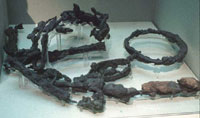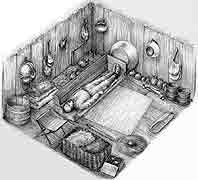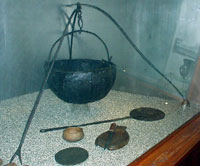To those serious about re-creating the historical Middle Ages, there exists a serious problem. Time is a glass through which we can at best only glimpse the past darkly. The further back you try to look, the more imperfect your vision becomes. Time is a kind of filter that will reduce both artifacts and writings to a random scatter. The historic material available is kind of a funnel shaped pile, quite wide if you're looking at last week, but extremely thin for a thousand years ago. If looking at the history of the last 150 years, we have the clear records of photography. In the near past, writings from the time give us a detailed picture of events, usually at the hand of those directly involved. By the point we reach the Middle Ages however, writings become more derivative, accounts often being recorded many decades after the fact, by those not even remotely involved in the events. As well, the personal point of view and lack of knowledge of the writer more and more warps the facts. Can you really trust the descriptions of the Norse written by an Irish monk?
| Artifact evidence also undergoes a similar reduction. The perishable nature of many materials becomes a significant barrier to their continued existence. Common everyday items are discarded, while the unusual are cherished. The useful are worn away and broken, while the simply decorative remains intact. Items made of glass, ceramic and gold endure, while wood, cloth and iron rots away. Look far enough back in time, and luck seems to play the greatest role in determining what is preserved. | |
| For the 'Dark Ages', artifacts often become much more important than text. Compare the grave goods from Sutton Hoo and the few entries from the Anglo-Saxon Chronicles for the same period. This is especially true when combined with the kind of detailed examination of archaeological sites that is used today, where insect parts and pollen grains can tell us what colour cloaks were being worn. (In fact, since only a very few samples of early period textile have been found, dead bugs and the contents of outhouse pits often tell us more about period dyes than these scraps of cloth can.) The wear patterns on a tool can tell you how it was held. Holes in armour yield information on weapon type, effectiveness and fighting styles. Just what is found, and where, can give hints to settlement patterns, dwelling designs, even insights into religion. But you have to be careful with artifacts, because sometimes they lie. |
While I was working as an interpreter at a 1860's historic site, we daily made use of artifacts 130 to 180 years old. Over the years a few things became apparent about these artifacts, and why we still had them around. If you think about it, why does something hang around for two centuries? If a thing is useful, it gets worn out. Do you have an old carving knife at home that has been sharpened so many times that it now looks like a fish filleting blade? How may more years until it's worn right away? If you lose something, and it gets found years later, it may still be in good shape, providing the environment hasn't corroded it. Of course if you never use something, but still keep it, it should pass down the years in excellent condition.
And so to the two classes of artifacts mentioned in the title, namely 'Aunt Marthas' and 'Damnthings'.
If you're married, I bet you have a few 'Aunt Marthas' at home. If you've ever been to an estate auction, you've seen a collection of 'Aunt Marthas'. Remember that wedding gift you got, usually from a older maiden aunt? You know, the porcelain statue of the little girl and her kittens or the plastic Virgin Mary combination barometer and night light? And you said "Thank you so much Aunt Martha, I've never received a gift quite like it, I'll always keep it safe in a special place of honour." And so you packed it back in its box and stuffed it into the basement crawl space and tried to forget about it. The great lava lamp you got from your best friend Ernie, got put out on the top of bookcase were you could watch it for hours. Mere hours is all you got to look at it, because your mountain climber of a cat knocked it off the shelf the very next day. Fifty years latter you die. And what objects remain as a measure of your life? You guessed it, all the 'Aunt Marthas' carefully packed away in your crawl space. (Sounds like a Steven King novel!) Will these pieces accurately define your life and times?
So how about the other class of artifact, the 'Damnthing'? Remember the K-tel record holder that flipped through your collection automatically, then proceeded to flip your records on to the floor? Damn thing never did work! Or the illuminated car dash mounted compass that cost $30 and then only ever pointed north? Damn thing never did work! You probably tossed out the record holder, but the compass was expensive, so you boxed it up, and stored it in a milk crate in the garage. Fifty years later you die. And what objects remain as a measure of your life? You guessed it, all the 'Damnthings' carefully packed away in you garage.
So what artifacts are we left with that represent your past? A plastic lamp you hated and an useless car gizmo. From the evidence, you must have been a deeply religious person (as represented by the icon) who travelled widely and precisely (as represented by the navigation device).
| You have to be careful how closely you can draw parallels between modern practices and those used in to past. I mean, did King Raedwald of Sutton Hoo have a garage or an Aunt Martha? It is true that the elaborately decorated helmet found there seems to show no signs of combat use. So how does it really compare to 'real' armour of the times? The complex cauldron hanger in the grave has no mechanism to control its height over a fire. Does this make it a Damnthing? |
Obviously any object from a given historic period can tell us something important about about the life in those times. But the lesson of the Aunt Martha and the Damnthing warns us that things may not always be what they seem. Documents and artifacts must be evaluated in the light of other physical evidence and the proper cultural viewpoint. An artifact can prove what existed, but to find out why it existed, how common it was, or what it was used for, other evidence must be examined.


